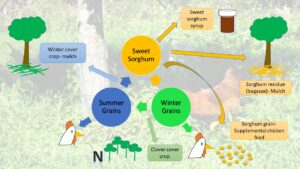Project Overview
Commodities
- Agronomic: sorghum (sweet)
- Fruits: apples
- Animals: poultry
Practices
- Crop Production: agroforestry
Summary:
In our region of Kentucky, many growers have been seeking alternatives for growing tobacco. Incorporating trees into agricultural systems on land previously used to grow tobacco is a viable alternative. Agroforestry has the potential to increase farm profitability and provide environmental benefits. However, farmers need income while fruit and nut trees become established. Growing a crop between trees, called alley cropping, can provide early cash flow. Raising livestock is another option to generate early returns, and has the added benefits of improving soil fertility and helping to control pests.
Many producers are returning to pasturing birds to improve animal welfare, meat quality and environmental outcomes. However, even in pasture-based systems, most of the feed is purchased off-farm with pasture mainly providing bioactive compounds, vitamins, and limited amounts of protein. Producing grain for feed is by far the biggest factor when considering the environmental impacts of poultry production. Offsetting even a portion of the feed grown off-site should reduce negative impacts and benefit a farmer's bottom line, as feed accounts for up to 65 percent of the cost of poultry production.
Before commercial feed was widely available, farmers recognized the need for a balanced diet including a variety of grains and green forage. They planted crops such as barley, oats and wheat for poultry to graze while it was young and tender. Farmers have long recognized the nutritional wisdom of chickens -- the ability to select a balanced diet when given a choice of ingredients. Free choice feeding of whole grains alongside supplemental protein and mineral sources has the potential to lower feed cost without sacrificing performance. Whole grain feeding also helps prevent coccidiosis, a widespread disease that is usually managed by the prophylactic addition of medications to poultry rations.
We propose to evaluate an agroforestry system that incorporates sweet sorghum, pasture broilers that self-harvest their feed, and young fruit trees.
Project objectives:

After the sorghum is harvested, a mix of winter crops (wheat, barley, triticale, and field peas) will be planted in the fall as feed for the broilers the following summer.
In a separate treatment, a mix of summer feed crops (sunflower, buckwheat, and millet) will also be evaluated as a source of self-harvested feed.
After these crops are harvested, a cover crop of cereal rye will be grown to capture nutrients and provide further mulch for the fruit trees. The sorghum and grains will be grown in the alleys between the rows of apples, which will be used for cider.